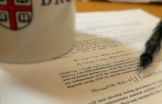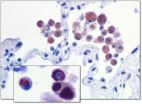(Press-News.org) Boston - April 8, 2014 - Babies and young children make giant developmental leaps all of the time. Sometimes, it seems, even overnight they figure out how to recognize certain shapes or what the word "no" means no matter who says it. It turns out that making those leaps could be a nap away: New research finds that infants who nap are better able to apply lessons learned to new skills, while preschoolers are better able to retain learned knowledge after napping.
"Sleep plays a crucial role in learning from early in development," says Rebecca Gómez of the University of Arizona. She will be presenting her new work, which looks specifically at how sleep enables babies and young children to learn language over time, at the Cognitive Neuroscience Society (CNS) annual meeting in Boston today, as part of a symposium on sleep and memory.
"We want to show that sleep is not just a necessary evil for the organism to stay functional," says Susanne Diekelmann of the University of Tübingen in Germany who is chairing the symposium. "Sleep is an active state that is essential for the formation of lasting memories."
A growing body of research shows how memories become reactivated during sleep, and new work is shedding light on exactly when and how memories get stored and reactivated. "Sleep is a highly selective state that preferentially strengthens memories that are relevant for our future behavior," Diekelmann says. "Sleep can also abstract general rules from single experiences, which helps us to deal more efficiently with similar situations in the future."
Making the leap from the abstract
In Gómez's new work, she and colleagues are examining how young children can recognize instances similar, but not identical, to something they have learned and apply it to a new situation – so-called generalization. Examples in language include the ability to recognize the letter "A" in different types of font, understanding a word regardless of who is speaking it, or recognizing a grammatical pattern in a sentence never before heard.
"Sleep is essential for extending learning to new examples," she says. "Naps soon after learning appear to be particularly important for generalization of knowledge in infants and preschoolers."
In one of her new studies, Gómez played an artificial "training language" over loudspeakers to infants 12 months old who were playing. They then tested whether the infants recognized novel vocabulary after either taking a nap or being awake.
Babies who napped after learning the artificial language were able to take the language rules learned before the nap and apply them to recognizing entirely new sentences in the language. The researchers measured recognition of the linguistic rules by the length of time infants spent with their heads turned to listen to correctly versus incorrectly structured sentences in the language.
To create the artificial languages in her studies, Gómez mimics structure in natural language that may be useful in language learning. For instance, nouns and verbs have subtly different sound patterns in many languages. "If I want to study whether these patterns help infants learn language at a particular age, I build stimuli with similar characteristics into an artificial language," she says. "I can then test children of different ages to see when they are able to use this information."
Gómez's team is also investigating the role of naps for preschoolers who are learning words. "Infants who nap soon after learning are able to generalize after sleep but not after a similar interval of normal waking time," she says. "Preschoolers with more mature memory structures do not appear to form generalizations during sleep; however, naps appear to be necessary for retaining a generalization they form before a nap."
The difference between learning and memory in infants versus preschool children could be the result of different neural mechanisms, Gómez says. Research on nonhuman primates suggests that while most of the substructures of the hippocampus are in place in infancy, the substructures that may support replay of memories during sleep do not begin wiring up until 16-20 months of age and then take several more years to reach maturity.
"Therefore, we hypothesize that the benefits of sleep in infancy stem from different processes than those benefiting preschoolers," she says. While in infants, sleep may contribute to forgetting of less redundant information in the stimulus – e.g. talker voice, the actual words infants hear over and above the rhythmic pattern occurring for all stimuli – Gómez says that hippocampally-based replay may begin to contribute to more active integration and retention of sleep-dependent memories in preschool-aged children.
Next, Gómez and her colleagues plan to study when in development children no longer need to nap to retain learned information. Prior work shows that children who nap less than 4 times a week are able to retain new memories during nighttime sleep. However Gómez's team's work shows that these children still need to nap within 4 hours after learning to generalize their knowledge to new instances in the future. More research is needed to pinpoint when the transition occurs to more adult-like memory retention after nighttime sleep.
Remembering what we want to do
Sleep not only helps us remember things that happened in the past but also helps us remember what we want to do in the future.
"Whether we make plans for the next holiday or whether we just think about what to have for dinner tonight, all of these plans heavily depend on our ability to remember what we wanted to do at the appropriate time in the future," says Diekelmann of the University of Tübingen. "The likelihood that we remember to execute our intentions at the appropriate time in the future is substantially higher if we have had a good night's sleep after having formed the intention."
There are two ways in which we can keep our intentions in mind, Diekelmann explains: One way is to think about the intentions all the time and constantly look for opportunities to execute them. "For example, if I want to drop a letter at the post office on my way to work, I can look for a post office all the way to my work place and think all the time 'I have to drop the letter.'" But this method, she says , is inefficient, as cognitive resources are necessary for other tasks like watching out for the traffic and maneuvering around people.
"The second way to remember intentions is to store them in the memory network," she says. "If the memory of the intention is stored well enough, it will come to mind automatically in the appropriate situation." For example, if the memory of the intention to drop the letter is stored strongly, then the intention will come to mind when passing the post office.
It is this second method that Diekelmann's team's recent studies sought to explore. In one new study, the researchers asked participants to remember word pairs, and after learning, told them they would have to detect these words in a different task two days later. They then let half of the participants sleep, while the other half stayed awake for one night. During the second night, all participants slept so that they would not be tired at testing.
In the test session, participants performed a task that included some of the previously learned words from the pairs. The researchers did not remind the participants of their intention to detect the words but just recorded how many words they detected. They wanted to see whether participants still succeeded in detecting the words when they had to do an additional task at the same time that required their full attention. "We expected that, if participants had stored the intention sufficiently strong in their memory, then seeing the words should automatically bring to mind the intention to detect the words," Diekelmann says.
Indeed, the researchers found that participants who were allowed to sleep were able to automatically detect the words. "With sleep, the participants performed perfectly well and detected almost all of the words even when they had to perform two challenging tasks in parallel," Diekelmann says. Those participants who stayed awake during the first night after forming the intention, however, performed substantially worse in detecting words at the same time as other tasks.
"Even when we have to do a lot of different things at the same time, sleep ensures that our intentions come to mind spontaneously once we encounter the appropriate situation to execute the intention," Diekelmann says.
An ongoing goal of sleep and memory researchers is to find out how sleep selects which memories are worthy to store for the long-term. "It is generally believed that there is some kind of tagging mechanism that marks which memories are relevant and should be stored for the long-term and which are not," Diekelmann says. "Yet, we are far from understanding what that tagging mechanism is and how it works."
INFORMATION:
Diekelmann and Gómez are presenting their work, along with Ken Paller and Jessica Payne, in the symposium "Mechanisms of Memory Consolidation During Sleep," Tuesday, April 8, 2014 at the CNS annual meeting in Boston. More than 1,500 scientists are attending the meeting in Boston, MA, from April 5-8, 2014.
Follow the meeting on Twitter: @CogNeuroNews, #CNS2014 and read our blog for ongoing coverage.
CNS is committed to the development of mind and brain research aimed at investigating the psychological, computational, and neuroscientific bases of cognition. Since its founding in 1994, the Society has been dedicated to bringing its 2,000 members worldwide the latest research to facilitate public, professional, and scientific discourse.
From learning in infancy to planning ahead in adulthood: Sleep's vital role for memory
2014-04-08
ELSE PRESS RELEASES FROM THIS DATE:
Innovative, coordinated brain care could save billions of health care dollars
2014-04-08
INDIANAPOLIS -- Studies have shown that a new patient and caregiver centered model of innovative, coordinated brain care for older adults improves health outcomes and quality of care for those with cognitive impairment. A new study from the Regenstrief Institute, Eskenazi Health and Indiana University Center for Aging Research implementation scientists who developed the Healthy Aging Brain Center care model shows that such care also produces impressive cost savings.
The Healthy Aging Brain Center care model generated an annual net cost savings of up to $2,856 per patient ...
New epidemiology model combines multiple genomic data
2014-04-08
PROVIDENCE, R.I. [Brown University] — The difference between merely throwing around buzzwords like "personalized medicine" and "big data" and delivering on their medical promise is in the details of developing methods for analyzing and interpreting genomic data. In a pair of new papers, Brown University epidemiologist Yen-Tsung Huang and colleagues show how integrating different kinds of genomic data could improve studies of the association between genes and disease.
The kinds of data Huang integrates are single-nucleotide differences in DNA, called SNPs, data on gene ...
Western University study unlocking secrets of breast tissue
2014-04-08
A unique population of microbes in the female breast may lay the groundwork for understanding how this bacterial community contributes to health and disease, according to a new study out of Western University (London, Canada). The study titled "Microbiota of human breast tissue," is now published online, in advance of the May issue of Applied and Environmental Microbiology.
The human body is home to a large and diverse population of bacteria with properties that are both harmful and beneficial to our health. Studies are revealing the presence of bacteria in unexpected ...
Expanding particles to engineer defects
2014-04-08
Materials scientists have long known that introducing defects into three-dimensional materials can improve their mechanical and electronic properties. Now a new Northwestern study finds how defects affect two-dimensional crystalline structures, and the results hold information for designing new materials.
In packed, two-dimensional crystalline systems, such as in photonic two-dimensional crystals, the particles are organized in hexagonal lattices. One particle is in the center of the hexagon with six neighboring particles around it. A defective lattice is when the center ...
More insights from tissue samples
2014-04-08
This news release is available in German.
They discovered that the so-called HOPE method allows tissue samples to be treated such that they do not only meet the requirements of clinical histology, but can still be characterised later on by modern methods of proteomics, a technique analysing all proteins at once. This is successful, since the structure of the tissue is "fixed" in a way that the protein molecules remain accessible for systematic analysis. This technique therefore meets current requirements in terms of a more personalised medicine and thus opens up ...
Few Americans know where elected officials and candidates stand on government support for research
2014-04-08
ALEXANDRIA, Va.—April 8, 2014—Two-thirds of Americans (66%) say it's important for candidates running for office to assign a high priority to funding medical research, according to America Speaks, Volume 14, a compilation of key questions from public opinion polls commissioned by Research!America. Polling shows that Americans place a high value on U.S. leadership in medical innovation, yet only 12% say they are very well informed about the positions of their senators and representative when it comes to their support of medical and scientific research. http://www.researchamerica.org/poll_summary. ...
Thinking about a majority-minority shift leads to more conservative views
2014-04-08
Facing the prospect of racial minority groups becoming the overall majority in the United States leads White Americans to lean more toward the conservative end of the political spectrum, according to research published in Psychological Science, a journal of the Association for Psychological Science.
The findings suggest that increased diversity in the United States could actually lead to a wider partisan divide, with more White Americans expressing support for conservative policies.
Psychological scientists Maureen Craig and Jennifer Richeson of Northwestern University ...
Logo color affects consumer emotion toward brands, MU study finds
2014-04-08
COLUMBIA, Mo. – Many studies have shown that a company's logo is one of the most important aspects of marketing and advertising a brand, or features that distinctly identifies a company's product or service from its competitors. Now, a researcher at the University of Missouri has found that the specific colors used in a company's logo have a significant impact on how that logo, and the brand as a whole, is viewed by consumers.
Jessica Ridgway, a doctoral student in the MU Department of Textile and Apparel Management, surveyed 184 adults using generic logos of different ...
Synthetic gene circuits pump up cell signals
2014-04-08
Synthetic genetic circuitry created by researchers at Rice University is helping them see, for the first time, how to regulate cell mechanisms that degrade the misfolded proteins implicated in Parkinson's, Huntington's and other diseases.
The Rice lab of chemical and biomolecular engineer Laura Segatori has designed a sophisticated circuit that signals increases in the degradation of proteins by the cell's ubiquitin proteasome system (UPS).
The research appears online today in Nature Communications.
The UPS is essential to a variety of fundamental cellular processes, ...
Unexpected results in cancer drug trial
2014-04-08
Research from the University of Southampton has shown a drug, used in combination with chemotherapy to treat advanced colorectal cancer, is not effective in some settings, and indeed may result in more rapid cancer progression.
The New EPOC study, published in The Lancet Oncology and funded by Cancer Research UK, evaluated whether the drug cetuximab and chemotherapy together worked better than chemotherapy alone as a treatment in addition to surgery for people with bowel cancer that had spread to the liver but could be surgically removed. In the trial patients either ...


